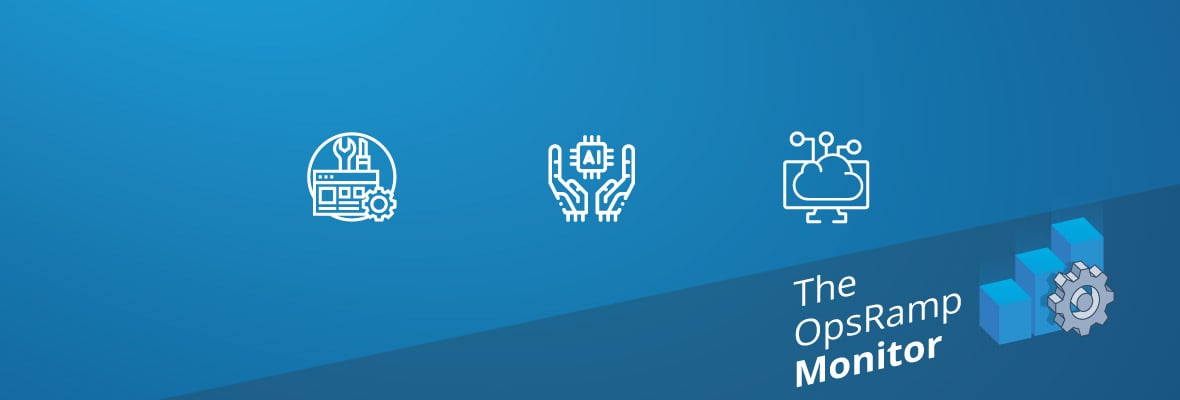Top Weekly Reads in IT I&O
The OpsRamp Monitor is OpsRamp’s top weekly review of interesting developments and emerging trends in IT operations. Subscribe to our blog for the latest and greatest in monitoring, DevOps, AIOps and cloud computing and stay on top of everything Ops.
In this issue:
- Free offers from remote work tech leaders
- How to share incident information with employees
- Cloud native techs can save legacy apps.
- Best cloud for AI development
- More options for container management
It’s been another brutal week. The coronavirus a.k.a. “Rona” as my teenage daughter and her friends call it, is just making things miserable for everyone. There have been significant impacts on the tech sector, along with oil and gas, finance, travel, hospitality, and many other industries. But there’s always a silver lining when disaster strikes. So let’s start on a positive note: many of us in information worker roles can work from home. Twenty years ago, this really wasn’t possible.
Embrace remote work. Big vendors like Cisco, Microsoft and Google are giving more latitude with free versions of their collaboration and conferencing tools, to help people needing to work at home because of the virus. A Microsoft spokesperson told CIO Dive in a statement Tuesday: "By making Teams available to all for free for six months, we hope that we can support public health and safety by making remote work even easier." These might be thinly-veiled attempts to grow market share, but it's generous nonetheless. More interesting is a comment about the CIO role during this time of crisis: “This is an opportunity for CIOs to be proactive in supporting the business and recognizing what something like the outbreak might mean, whether that's remote work or overall business continuity.”
Bearers of bad (IT) news. We’re talking about incident communications. As reported in Tech Target: “Some users want more details, some fewer, some don't care and some don't understand what was said.” While this sounds like the typical all-American dysfunctional family, the author’s advice cuts across all individual needs: keep it accurate, clear, short and sweet. And by all means, respond promptly. “Don't spend half the message on an apology or justification for the outage; just say clearly and concisely which systems are broken, whom it might affect, if there's an estimated fix time and any applicable workarounds.” Also: send out a post-mortem with more detail on what happened and why, once things are back to normal.
A little love for legacy (apps). It’s hard to find a reliable statistic for the prevalence of legacy applications in enterprise environments, but we know it’s still pretty high. The term “legacy” seems to be a dirty word these days in the age of microservices and cloud, but the reality is many organizations rely on these applications to serve their core markets. They’ve been customized and retain important institutional knowledge and processes that are paramount to the business. However, they’ve got to be optimized to run in modern, distributed environments and integrate with cloud systems. This New Stack article discusses how cloud native technologies can modernize the legacy world: “DevOps teams can modernize APIs, complete extract, transform and load (ETL) tasks through workers hosted on serverless functions and develop applications on serverless infrastructure that can also be used to manage legacy infrastructure.” The article also goes into tips for transitioning into cloud-native development and management.
The best cloud for AI developers. All of the major cloud services are investing heavily in AI tools and enabling technologies. While Google has always been known as the developer platform, this article in Virtualization Review highlights AWS as the best place to develop AI applications, based on research from Gartner: “AWS offerings can support the needs of developers across many skill levels, from those with little AI/machine learning experience to those who are more advanced. [AWS] also offers courseware and consulting services for developers and organizations looking for more expert guidance on machine learning projects.” The research gave Microsoft Azure second place, because of its “variety of deployment options for enterprises” as well as having “one of the largest selections of languages for its natural language services.”
Edge, whatever. Data Center Knowledge writes that edge has been over-hyped and will likely be a forgotten fad in 10 years. First, the author provides a useful definition: “Data in an edge computing architecture spends most of its life on the edge of the cloud instead of in the center, so to speak.” But then, he goes on to pick the trend apart:
- Edge is somewhat meaningless as there’s no clear boundary as to where it begins. “What if you use an on-premise data center to do some data processing to complement operations hosted in a public cloud? That could also be considered an example of edge computing architecture. But it might also be interpreted merely as a hybrid cloud infrastructure.” Good point.
- Edge is not new. Among other examples is this one: “One of the tenets of cloud architecture 101 is that you should select cloud regions that are close to your users. That’s not an innovation that emerged out of the edge computing revolution.”
- The value prop is half-baked. “I’m not sure that cutting out milliseconds’ worth of data transfer delays is really going to revolutionize many end user experiences.”
And a final word about containers. We’ve got some container news this week from VMware and HPE. VMware just announced that its new vSphere release will support Kubernetes so that customers can simultaneously run containers and virtual machines in the hybrid cloud. HPE, a competitor in the hybrid cloud space, announced the release of the HPE Container Platform, which the company says can run containerized applications on virtual infrastructure or bare metal, and on premise, in the public cloud or on the edge. In an about-face to cloud and virtual infrastructure, HP’s chief architect of the product was quoted: “We believe that we can reduce the total cost of ownership for customers if they run on bare metal,” he said. Well, there’s nothing like options!
Next Steps:
- 451 Research Review of the OpsRamp Winter Release.
- Learn about the OpsRamp Platform.
- Subscribe to the OpsRamp Blog!






